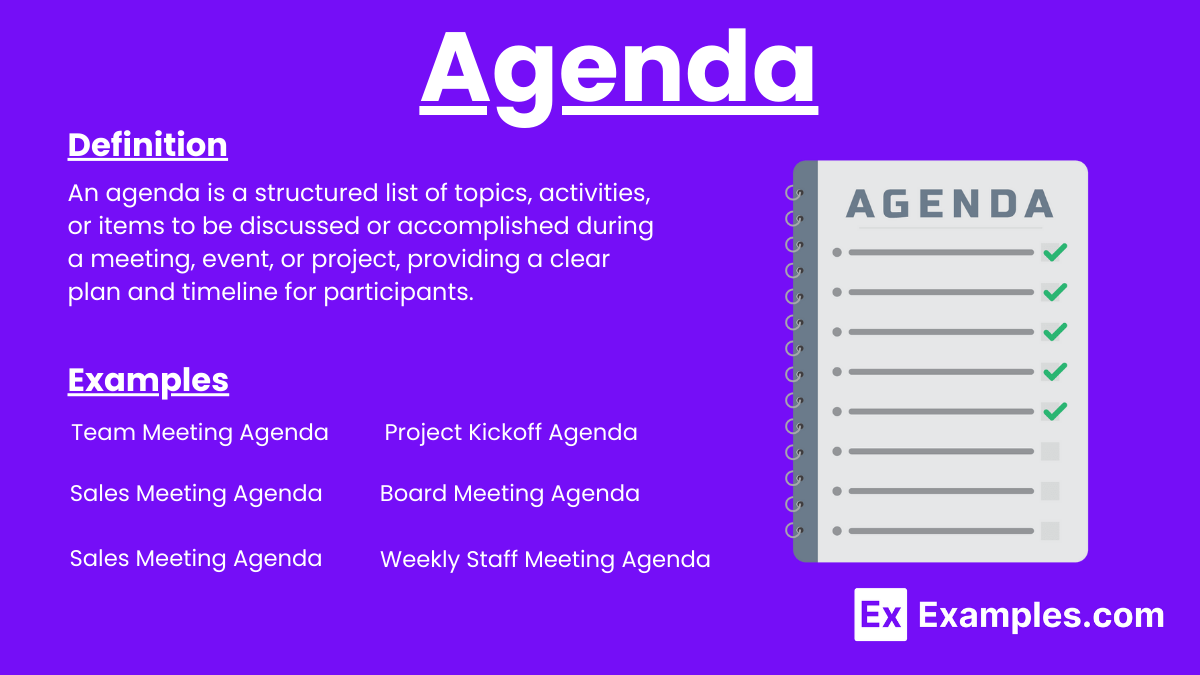18+ Agenda Examples to Download
An agenda serves as a structured roadmap for meetings or events, outlining the sequence of topics to be discussed. It typically begins with essential information such as the date, time, and location of the gathering. The work agenda, positioned centrally within this document, details the specific tasks, objectives, or issues to be addressed. By organizing discussions and allocating time slots, agenda templates can be used to ensure meetings stay focused, productive, and aligned with the intended goals, fostering efficient communication and decision-making among participants.
What is Agenda?
An agenda is a list or outline of items to be discussed or accomplished during a meeting, event, or project. It serves to organize and prioritize topics, allocate time, and guide participants towards achieving specific objectives or goals efficiently.
Agenda Examples
- Team Meeting Agenda – Outlines topics for regular team updates and discussions.
- Project Kickoff Agenda – Sets the stage for a new project, covering goals, roles, and timelines.
- Sales Meeting Agenda – Focuses on sales performance, strategies, and targets.
- Board Meeting Agenda – Covers high-level governance issues, financials, and strategic planning.
- Weekly Staff Meeting Agenda – Reviews weekly progress, issues, and upcoming tasks.
- Client Meeting Agenda – Structures discussions with clients to address their needs and project status.
- Annual General Meeting Agenda – Summarizes yearly achievements and plans for the next year.
- Training Session Agenda – Details the topics and schedule for training sessions.
- Problem-Solving Meeting Agenda – Focuses on identifying and resolving specific issues.
- Strategic Planning Agenda – Outlines long-term objectives and the strategies to achieve them.
- Budget Review Agenda – Examines financial performance and budget adjustments.
- Marketing Meeting Agenda – Discusses marketing strategies, campaigns, and performance.
- Performance Review Agenda – Reviews employee performance and sets future goals.
- Event Planning Agenda – Details planning steps for organizing events.
- Brainstorming Session Agenda – Encourages idea generation for new projects or initiatives.
- Progress Review Agenda – Evaluates ongoing projects and necessary adjustments.
- Committee Meeting Agenda – Structures discussions for committee-specific issues and actions.
- Emergency Meeting Agenda – Addresses urgent issues requiring immediate attention.
- Feedback Meeting Agenda – Gathers and discusses participant feedback to improve processes.
Agenda for Meeting
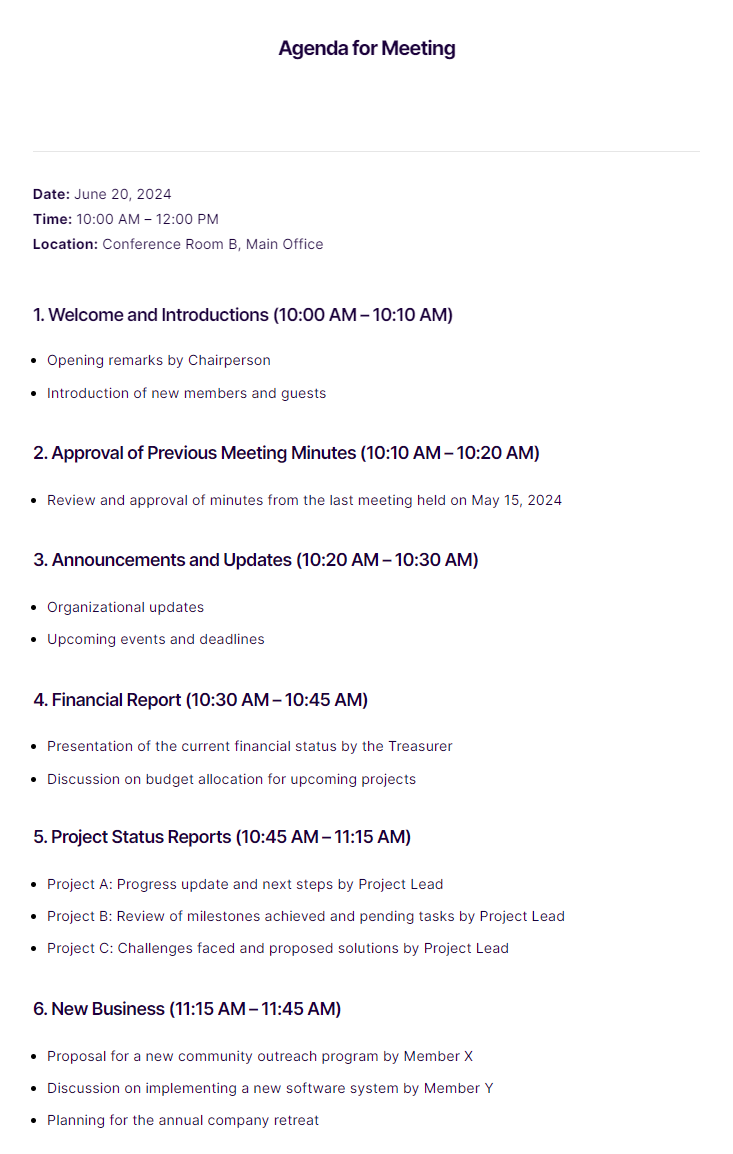
Agenda for Students
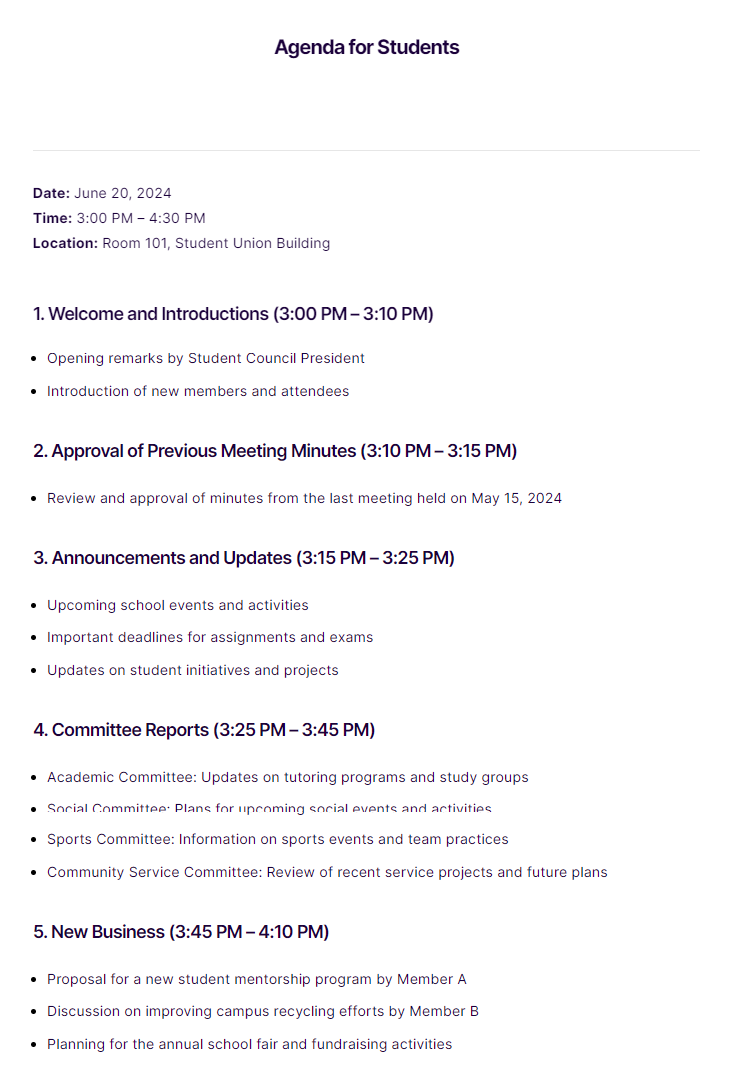
Agenda for Community Fundraising Event
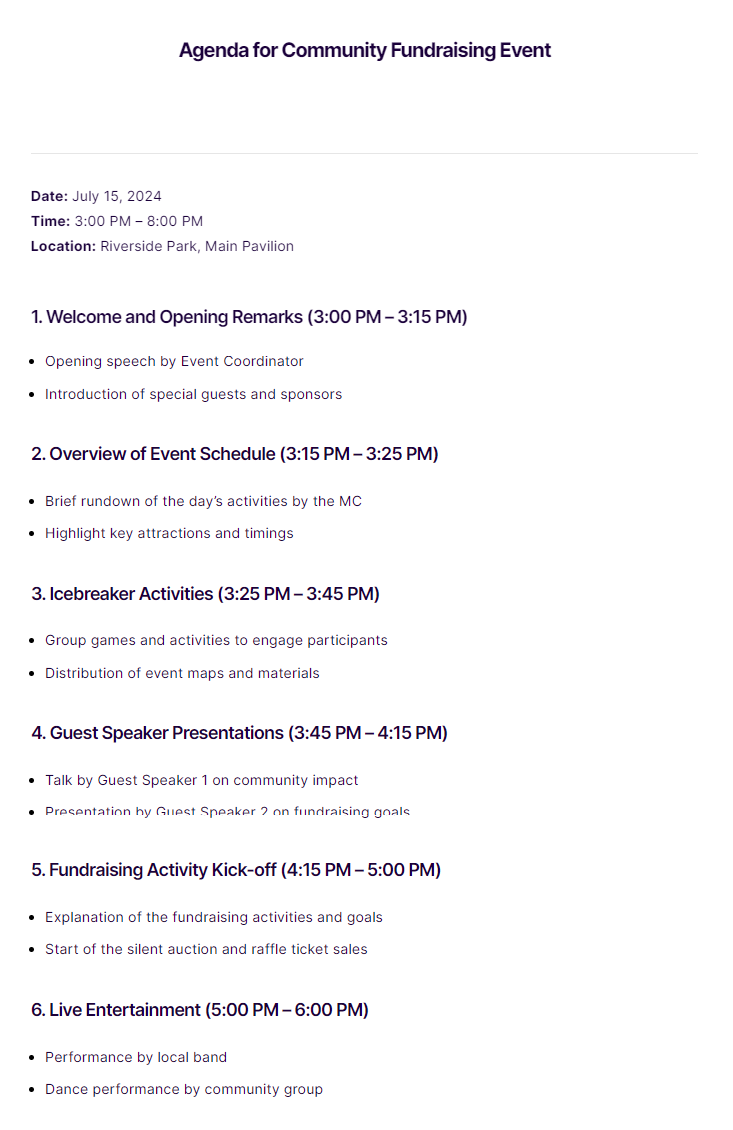
- Agenda for Business
- Agenda for Staff Meeting
- Agenda for Market Meeting
- Agenda for Project Meeting
- Agenda for Formal Meeting
- Agenda for Board Meeting
- Agenda for Club Meeting
Types of Agenda
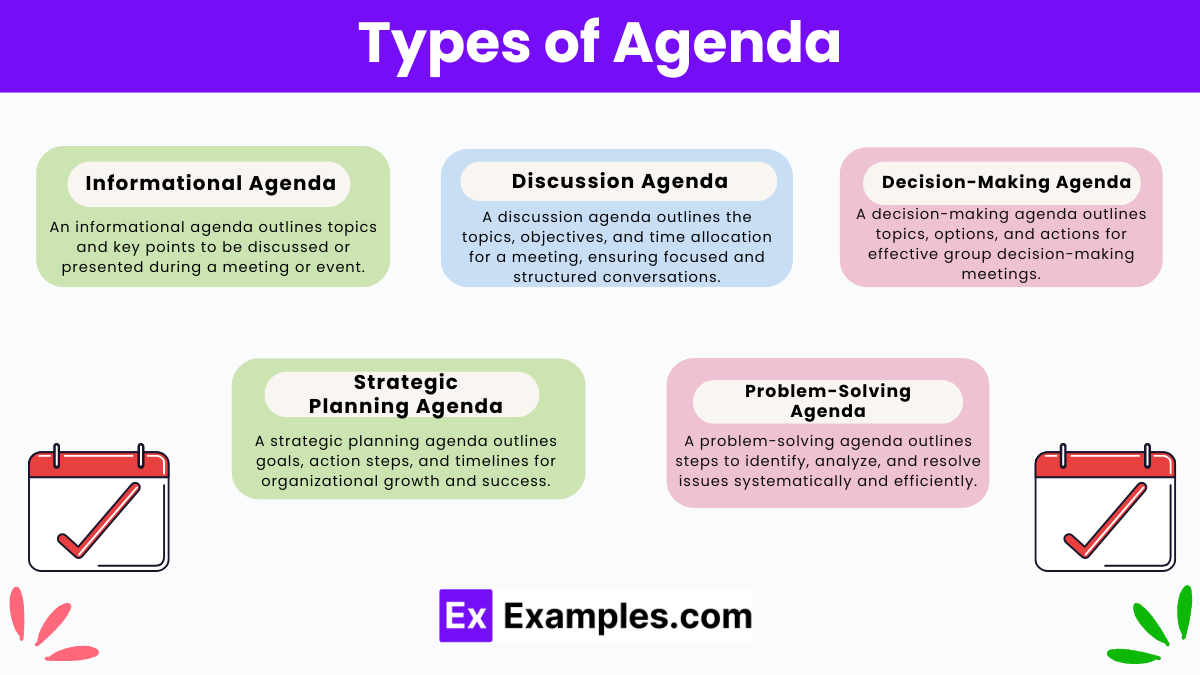
- Informational Agenda – Provides updates and details on specific topics without requiring decisions or actions.
- Discussion Agenda – Focuses on exchanging ideas and generating conversation around key topics or issues.
- Decision-Making Agenda – Centers on making decisions about important matters, often involving voting or consensus.
- Strategic Planning Agenda – Outlines long-term goals and strategies for achieving them, usually involving high-level discussions.
- Problem-Solving Agenda – Identifies and addresses specific problems, aiming to find effective solutions.
- Progress Review Agenda – Evaluates ongoing projects or initiatives, checking status and making necessary adjustments.
- Collaborative Agenda – Encourages teamwork and cooperation on shared projects or goals.
- Brainstorming Agenda – Promotes creative thinking and idea generation for new projects or initiatives.
- Training Agenda – Focuses on developing skills and knowledge through educational sessions.
- Feedback Agenda -Collects feedback from participants to enhance and refine processes or projects.
How to Create an Agenda Template
- Define Purpose – Identify the purpose of the meeting to create a focused Business Agenda.
- Set Time Frame – Decide if the agenda is for a specific meeting or a Weekly Agenda to cover ongoing topics.
- List Topics – Outline the key topics and issues to be discussed in the agenda.
- Allocate Time – Assign time slots for each topic to ensure a balanced and effective meeting.
- Design Format – Choose a clear and organized format for the agenda, making it easy to follow.
- Include Details – Add relevant details such as date, time, location, and participants to the agenda template.
What Is the Purpose of an Agenda?
- To serve as a meeting notice that all the expected meeting attendees should review and be aware of.
- To arrange all the discussion items that should be presented and assessed within a meeting.
- To list down the accurate measures to be followed by the entities involved in implementing the content of the agenda.
- To prepare in advance all the necessary steps that an organization must incorporate to their meeting and/or operations.
How Do You Make a Quality Agenda for a Business Meeting?
- Define the Meeting Objectives – Clearly state the purpose of the meeting and the desired outcomes.
- List Agenda Items – Identify and prioritize topics to be discussed. Include items like progress updates, decision points, and strategic planning.
- Allocate Time for Each Item – Assign a specific time duration for each agenda item to keep the meeting on track and ensure all topics are covered.
- Assign Responsibilities – Indicate who will lead each discussion point or present information. This ensures accountability and preparation.
- Distribute the Agenda in Advance – Share the agenda with participants ahead of time, allowing them to prepare and contribute effectively.
- Include Time for Q&A and Wrap-Up – Allocate time at the end for questions, clarifications, and summarizing action items.
- Use a Template – Utilize a structured template to ensure consistency and comprehensiveness.
Why Is an Agenda Important?
- Sets Clear Objectives – An agenda defines the purpose and goals of the meeting, ensuring everyone understands what needs to be achieved.
- Organizes Topics – It structures the discussion points, prioritizing important issues and allocating time appropriately.
- Enhances Preparation – By outlining topics in advance, participants can prepare, leading to more informed and productive discussions.
- Maintains Focus – An agenda keeps the meeting on track, preventing deviations and ensuring all key points are covered.
- Facilitates Follow-Up – It provides a reference for action items and next steps, ensuring accountability and progress post-meeting.
Why Is Keeping an Agenda Beneficial?
- A nonprofit agenda can help in maintaining the effective implementation of the activities of a non profit group or organization. This allows them to be aware of the things that they need to do to make sure that the individual members of the group are aware with their responsibilities.
- Keeping a development agenda can help either a business or an individual track their performance and the items that they need to be knowledgeable about so they can further improve their current condition.
- Keeping an agenda means that an entity can already have a reference on how they plan and how the plans that they have created are implemented accordingly.
Why Do You Need a One-on-One Meeting Agenda?
A one-on-one meeting agenda is essential for maintaining structure, ensuring all key topics are addressed, and making the most of the limited time. It helps in setting clear objectives, tracking progress, and fostering open communication. By using a detailed meeting agenda, both parties can prepare effectively, leading to more productive and meaningful discussions.
Benefits of an Effective Meeting Agenda
- Increases Focus – Keeps discussions on track and relevant to the meeting’s objectives.
- Saves Time – Ensures meetings run efficiently by outlining clear topics and time limits.
- Promotes Preparation – Allows participants to prepare in advance, leading to more productive discussions.
- Clarifies Objectives – Clearly defines the meeting’s goals, helping attendees understand the purpose.
- Enhances Participation – Encourages active involvement by providing a structured outline of topics.
- Improves Accountability – Assigns specific responsibilities and follow-up tasks to individuals.
- Facilitates Decision-Making – Organizes topics to support timely and effective decisions.
- Reduces Confusion – Minimizes misunderstandings by providing a clear structure and focus.
Why is an agenda important?
It helps organize discussions, prioritize topics, and manage time effectively.
How do you create an agenda?
Start with goals, list topics, allocate time, and distribute it before the meeting.
What should an agenda include?
Date, time, location, topics, and participants’ roles.
How do agendas improve meetings?
They keep discussions focused, ensure everyone is prepared, and enhance productivity.
What is the difference between an agenda and minutes?
An agenda outlines what will be discussed, while minutes record what was discussed and decided.
Who creates the agenda?
Typically, the meeting organizer or facilitator creates the agenda.
Can agendas change?
Yes, agendas can be adjusted based on emerging issues or time constraints.
How detailed should an agenda be?
It should be detailed enough to guide the meeting but flexible for adjustments.
How can agendas be shared?
They can be shared via email, collaboration tools, or printed copies.
Are agendas necessary for small meetings?
Yes, even small meetings benefit from an agenda to stay organized and on track.


